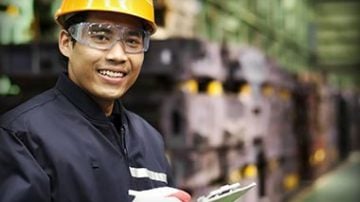The Occupational Safety and Health Act, or OSHA, has administered safe workplace regulations and practices since 1970. Unfortunately, companies don’t always adhere to these rules and regulations as they should, which results in continual workplace injuries and deaths. Anyone working in the industrial sector must know about these OSHA regulations to improve their personal and workplace safety. Specifically, knowing about these three OSHA violations in construction and how to prevent them can help reduce workplace incidents.
Fall Protection
Falling is one of the most dangerous parts of working in construction. When building structures over two stories tall, any elevation poses a safety risk for workers. Construction crews who cut corners on fall protection increase workplace hazards, such as holes, trenches, pits, ramps, heavy machinery, and building chutes to name a few. Some ways to reduce falling debris or falls in construction sites include wearing hats onsite, installing guardrails near openings, and implementing a fall protection safety plan.
Scaffolding
Scaffolding issues are another one of the top three OSHA violations in construction you should know how to prevent. Scaffolds aren’t the sturdiest of platforms, and workplace incidents happen often. Scaffolding mishaps often result in serious injury or pose fatal consequences from being loaded past their maximum payload, having unbalanced planks or platforms, lack of guardrails, or an inadequate structural foundation. All employees must know OSHA’s scaffolding training requirements to better understand these issues. Site managers should further inspect all scaffolds before work has started to ensure safety for all workers.
Eye, Face, and Respiratory Protection
Construction crews use many different materials for building structures. Therefore, it’s no surprise that face, eye, and respiratory problems are major threats to worker health and safety. Construction workers ingest or expose themselves to dust, fumes, chemicals, gas, smoke, and other hazardous materials on a frequent basis. All job sites must ensure proper personal protection equipment for proper coverage. Supervisors must train all workers on proper maintenance and usage of these PPE devices and other proper control measures to reduce bodily safety issues like these.
For more information on OSHA compliance and safety protocols, reach out to us at Industrial Compliance and Safety. We’re the leading safety compliance consultants dedicated to improving safe work practices in construction, mining, oil and gas, transportation, energy, trucking, and more. We currently offer various safety training programs as packages or individually, which cover actively using safety data sheets (SDS) and safety checklists, grade vetting and violations, document retention and auditing, updating training manuals, and employee training. We also use toolbox talks. Our professional safety consultants strive to improve your workplace with the most appropriate training and education available.





